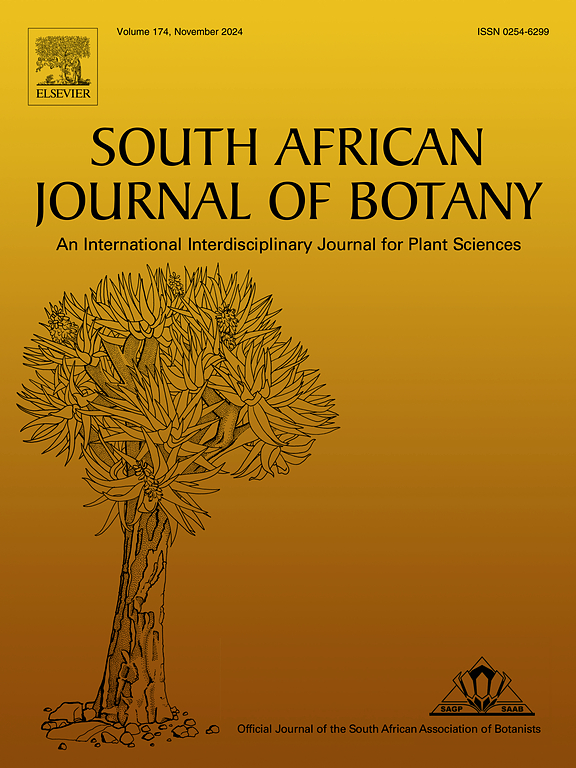Myricitrin, kaempferol-3-O-rutinoside, and rutin from Acacia tortilis (Forssk.) Hayne ssp. raddiana alleviate liver injury in carbon tetrachloride (CCl4)-intoxicated rats
IF 2.7
3区 生物学
Q2 PLANT SCIENCES
引用次数: 0
Abstract
Acacia tortilis ssp. raddiana has traditionally been employed to treat liver disorders. However, its hepatoprotective properties remain unexplored. This study investigated the phenolic composition, antioxidant potential, and hepatoprotective effects of the plant's ethanolic leaf extract. LC-MS analysis identified 11 phenolic compounds in the extract, with the glycosylated flavonoids myricitrin, kaempferol-3-O-rutinoside, and rutin being the most abundant. The extract exhibited potent antioxidant capacity, demonstrated by a DPPH radical scavenging capacity of 149.77 µg DW/mL and a ferric reducing antioxidant power value of 717.02 µmol TEAC/g DW. CCl₄-induced liver injury in rats significantly elevated serum levels of alanine aminotransferase, aspartate aminotransferase, and alkaline phosphatase, alongside increased malondialdehyde and decreased catalase and glutathione-S-transferase activities in liver homogenates. Pretreatment with the plant extract at 150 and 250 mg/kg BW effectively ameliorated these biomarkers, restoring them near control levels. Histopathological analysis corroborated these findings, revealing a marked preservation of liver tissue integrity and a reduction in hepatocyte degeneration and inflammatory cell infiltration at both dosages. These hepatoprotective effects could be attributed to the antioxidant and anti-inflammatory properties of myricitrin, kaempferol-3-O-rutinoside, and rutin. Acute toxicity evaluation at a dose of 2000 mg/kg BW revealed no mortality or signs of toxicity. These findings show that A. tortilis ssp. raddiana possesses properties that may contribute to liver protection against toxic substances, warranting further investigation into its potential therapeutic applications.
金合欢中的杨桃苷、山奈酚-3- o -芦丁苷和芦丁(福斯克)海ssp。小檗碱可减轻四氯化碳中毒大鼠肝损伤
墨西哥金合欢汤。Raddiana传统上被用来治疗肝脏疾病。然而,其保护肝脏的特性仍未被发现。本研究研究了该植物乙醇叶提取物的酚类成分、抗氧化潜力和肝保护作用。LC-MS分析鉴定出提取物中含有11种酚类化合物,其中糖基化黄酮类化合物杨梅三醇、山奈酚-3- o -芦丁苷和芦丁含量最多。提取物具有较强的抗氧化能力,对DPPH自由基的清除能力为149.77µg DW/mL,对铁的还原能力为717.02µmol TEAC/g DW。CCl 4诱导的肝损伤大鼠血清丙氨酸转氨酶、天冬氨酸转氨酶和碱性磷酸酶水平显著升高,肝匀浆中丙二醛升高,过氧化氢酶和谷胱甘肽s转移酶活性降低。150和250 mg/kg BW的植物提取物预处理有效改善了这些生物标志物,使其恢复到接近对照水平。组织病理学分析证实了这些发现,显示在两种剂量下,肝组织完整性得到了显著的保护,肝细胞变性和炎症细胞浸润的减少。这些肝保护作用可能归因于杨梅三醇、山奈酚-3- o -芦丁苷和芦丁的抗氧化和抗炎特性。在2000毫克/公斤体重剂量下的急性毒性评估显示没有死亡或毒性迹象。这些结果表明,玉米饼孢粉属植物。Raddiana具有保护肝脏免受有毒物质侵害的特性,值得进一步研究其潜在的治疗应用。
本文章由计算机程序翻译,如有差异,请以英文原文为准。
求助全文
约1分钟内获得全文
求助全文
来源期刊

South African Journal of Botany
生物-植物科学
CiteScore
5.20
自引率
9.70%
发文量
709
审稿时长
61 days
期刊介绍:
The South African Journal of Botany publishes original papers that deal with the classification, biodiversity, morphology, physiology, molecular biology, ecology, biotechnology, ethnobotany and other botanically related aspects of species that are of importance to southern Africa. Manuscripts dealing with significant new findings on other species of the world and general botanical principles will also be considered and are encouraged.
 求助内容:
求助内容: 应助结果提醒方式:
应助结果提醒方式:


